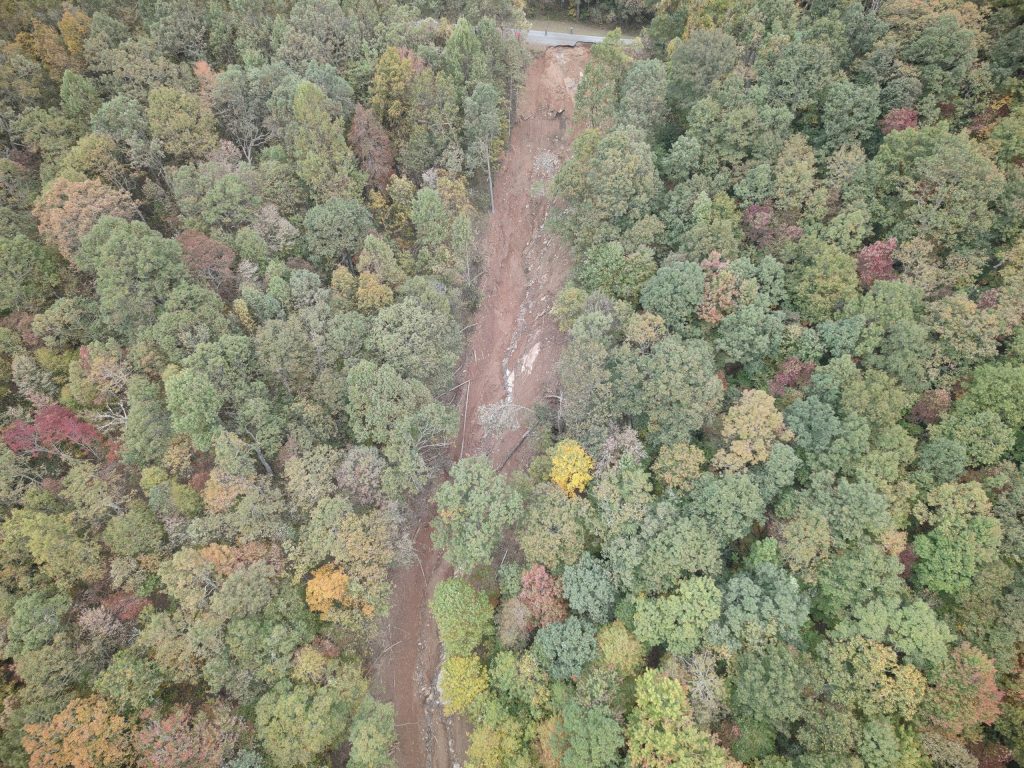Asheville – Nobody knows when the Blue Ridge Parkway and its associated trails, maintained by the National Park Service (NPS), will reopen. The park service reports that Helene’s 30 inches of rain in some areas and winds of 60 mph in others have caused damages that are still being assessed as work progresses.
The NPS has prioritized the reopening of key sections of the parkway, such as the stretch between Hendersonville Road and Brevard Road in Asheville, as well as the road leading to the Pisgah Inn. Some areas, like these, required little more than extensive debris removal; thousands of trees were cleared from the roadway in North Carolina and Virginia. All sections of the parkway in Virginia, where hurricane cleanup was less severe, are now open.
In North Carolina, repairs for 57 landslides and counting are ongoing. Between Mount Mitchell and Linville Falls, crews had to remove 30,000 cubic yards of muck and debris, piled 10 to 12 feet high, to access 45 landslides. In an 11-mile stretch in Asheville, 300 truckloads of debris were cleared.
Once the debris is removed, geologists can evaluate whether the ground beneath the road is stable. The parkway, after all, has “Ridge” in its name. Landslides may not be immediately visible, as there can be undercuts concealed by brush or even hidden within a solid exterior slope.
Where the ground appears intact, tests must be conducted to determine how much of it consists of loose soil or poses risks for traffic. A seemingly stable slope may be composed of limestone that can dissolve and wash away or consist of cracked rocks that can break loose as moisture freezes and expands.
Some areas are expected to remain under repair for years. One reason is that work in certain sections is proceeding sequentially; the road must be repaired before heavy equipment can access destruction on the other side. In some severely affected areas, planning and design phases will precede construction.
Many landslides have washed out large portions of the roadway. One near Asheville, at Milepost 401, extends hundreds of feet vertically into the valley.
Construction teams are currently removing loose debris and unstable bedrock on downward slopes. In most cases, once this is completed, new slopes with a terraced foundation will be built up to the roadway. The slope will then be leveled with soil and seeded. In addition to preparing roadbeds and laying and striping pavement, crews must construct necessary drainage systems, guardrails, and retaining walls.
Construction teams are also working on repairing park amenities, including visitor centers and pedestrian bridges. All trails that intersect with roads closed to automobile traffic are officially closed to all uses. Some signs indicate this, stating that trespassers could face fines and imprisonment. On other trails, parkway officials advise users to proceed at their own risk. All NPS trails are closed from the Linn Cove Viaduct Access Trail to the Mount Pisgah Trail.
The reasons for banning outdoor recreation during peak season include officials’ desire to avoid liability for injuries while heavy equipment is in use. Additionally, the geology of the parkway remains unstable; land could give way below, and boulders and trees could fall from above, traveling quickly and landing hard.
The US Forest Service’s Pisgah National Forest Appalachian Ranger District is being more lenient and transparent about allowed access to its trails. Closure dates can be found at fs.usda.gov.
Funding for hurricane reconstruction on the parkway is supplemented by a portion of the $2 billion Congress awarded to the NPS for disaster relief and $25 million from the USDOT. Prior to Helene, the parkway had $449 million in deferred maintenance, ranking as the 11th highest amount among national parks. On May 2, a bill was reintroduced to renew a five-year, $6.65 billion award to the NPS to address more than $23 billion in deferred maintenance.
Expect delays.

